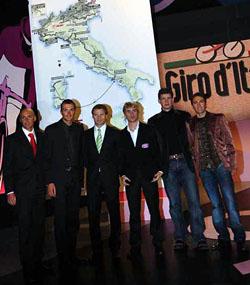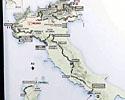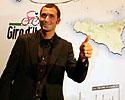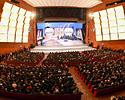
Recently on Cyclingnews.com |
90th Giro d'Italia - GT
Italy, May 12-June 3, 2007
90th Giro d'Italia celebrates the climbers
By Gregor Brown in Milano, Italy

|
The 90th edition of the Giro d'Italia will be one for the climbers. Although starting off in Sardegna with a team time trial, the parcours will contain more climbing than time trialing. Parting on May 12, the race will make its way from the south to the Alps and then to the Dolomites, before finishing in Milano, 3,442 kilometres later, on June 3.
"It is a Giro that I like a lot, for time trialists and for climbers," said 2006 winner Ivan Basso at the presentation.
"It is suited to me; it has a lot to offer for everyone," said 2004 winner Damiano Cunego.
There will be three stage days on the island of Sardegna, celebrating Giuseppe Garibaldi's 200th birthday, a team time trial, stage 2 (with the first categorized climb of the event) and the flat stage 3. The 24 kilometre time trial will take the teams from Caprera, past the home of Garibaldi, over bridge Passo di Moneta and to the finish in La Maddalena.
"The team time trail will be interesting because it is on the first day, and always the riders and teams will still be adjusting," said Paolo Savoldelli. "But the distance is short so it will not be that much of a factor."
And away we go
The Giro caravan will travel by boat to the mainland, in Salerno, while the riders will arrive by plane the night after stage 3. Tuesday, May 15, will be the first rest day. The following day the riders will immediately feel the kick of the Corsa Rosa as stage 4 from Salerno will finish on the Montevergine di Mercogliano, a 17.1 kilometre climb that touches gradients of 10%, the first of five mountain top finishes.
This climb has been used only twice, and both in recent history. The Killer, Danilo Di Luca, won on the climb in 2001 and in 2004 it was the turn of Damiano Cunego. That day in 2004 was significant for Cunego; riding in his Saeco stripes, he took the race lead from his senior teammate Gilberto Simoni and went on to win the Giro at only 22 years-old two weeks later. Over 17 kilometres long, at 5% average gradient, maybe this year the Mercogliano will give rise to a new super star.
The riders will then start their travels north, covering the Monte Terminillo in stage 6. Stage 8 will go over the Appennini mountain range and into Fiorano Modenese, where the race will finish on Ferrari's track, celebrating the car manufacturer's 60th year in business.
The next big appointment, and mountain top finish, will be stage 10 to Santuario Nostra Signora della Guardia. The stage will depart from Lido di Camaiore, travel along Cinque Terre, though Genova and then directly up the never-before-used nine kilometre climb. The climb may not dismantle the general classification but it will be a painful precursor for the days to come in the Alps and Dolomites.
The Giro will make a quick detour in to France for stage 12. The Colle dell'Agnello, this year's Cima Coppi at 2744 meters, will open the gate to France and the Colle d'Izoard. After the 14.15 kilometre climb, the race will scramble downwards for 23 kilometres to the finish in Briançon.

|
Before leaving the Alps the riders will have a chance to test themselves individually up the Santuario di Oropa. For the first time in years the Giro will include a mountain TT; a 13 kilometre run that rises 718 meters from Biella to Oropa. The climb has only been used three other times in the Giro's history, the last being in 1999 when Marco Pantani took the stage just prior to being booted out of the race.
"The mountain time trial is not really a friend of mine," said Basso, of the climb that averages 5.5% gradient and has a max of 13%. "The last one I raced did not go so well for me. We will have to see how the stage to Oropa goes."
"It is still a time trial, even though it is up a mountain," said two-time Giro winner Paolo Savoldelli. "You have to prepare and take it like a true time trial."
Tre Cime di Lavaredo
The next day the race makes a transfer to Cantù for the start of stage 14 to Savoldelli's home area of Bergamo. The Passo San Marco, a tough climb, will not be too decisive as it comes mid-way into the stage. However, the hum-dinger could be the next day, Sunday, to Tre Cime di Lavaredo. The Tre Cime di Lavaredo climb has been rarely used in the Giro's history; it was last scene in 1989 when Luis Herrera took the win.
The climb, touches 18% gradient near the top, is preceded by two brutal passes, the Passo di San Pellegrino (11.6 km long) and the Passo Giau (9.8 km). The two climbs combined will weaken the contenders’ legs so that the fans should see a real mountain battle when the riders reach the 7.15 km run up Tre Cime di Lavaredo.

|
The final week will take the Corsa Rosa into Austria before returning to Italia, where it will be marked by two significant stages. Stage 17 to Monte Zoncolan and stage 20 to Verona.
At the presentation in Milano, the Zoncolan was confirmed to be the climb that the riders fear the most. The climb was last used in 2003, when Gilberto Simoni took the stage on the way to winning the Giro d'Italia. The 10.1 kilometre climb, along with a long, narrow tunnel, contains sections of 22, 20 and 18% gradients, with an overall of 11.9%. Two-time Giro winner Simoni noted, "It will be a very open Giro. The arrival on Zoncolan is one I like a lot."
The riders will approach Zoncolan after leaving Austria. The Passo di Monte Croce di Comelico gives way to a mostly downhill run to the short explosion of Ravascletto; from there the riders will descend down into the valley towards Ovaro, where they will take a tight left-hander that will lead way to the Giro's final mountain top finish.
Any damage done to the legs on the Monte Zoncolan will have to be repaired over the following two days because on the Giro's penultimate day will be the final 42 of 79 kilometres in time trialing; a flat affair from Bardolino to Verona. Saturday's stage into the city of Romeo and Giulietta will be the only true individual time trial on offer in the Corsa Rosa.

|
A slight rise after departing from Bardolino is the only difficultly in the timed run. Race organizers RCS Sport will have a gem on their hands; if the classification is not locked up in the Dolomites there will be a battle for seconds into the romantic town. Or, if a mountain specialist has the race leader's maglia rosa then we could see him fight for his life to keep the jersey.
Of note is that RCS wanted to take the Giro into Verona for the final stage, perhaps finishing inside the famed Arena that sits in Piazza Bra, but due to a previously scheduled concert in the venue there will be no such finish. Instead, the final day, June 3, the riders will close the 90th edition of the Giro with the typical sprinters' stage into Milano.
Damiano Cunego, concluded, "there are a lot of tough stages, especially Zoncolan, and it is when you put them together that you start to realize it will a difficult Giro."
Cunego gave a smile when before the start of the presentation he saw the maglia bianca, similar to the one he won at this year's Tour de France. The white jersey for best young rider is making a comeback and replacing the blue Intergiro jersey in 2007. Used only 19-times in the Giro's history, Evgeni Berzin last won the jersey in 1994 on his to claiming the race's overall win.
Photography
For a thumbnail gallery of these images, click here
Images by Roberto Bettini/www.bettiniphoto.net
- Past winners (and Di Luca) pose in front of the 2007 Giro route
- 2007 Giro presentation
- 2006 winner Ivan Basso gives the new route a thumbs-up
- Ivan Basso will ride the 2007 Giro in Team Discovery kit
- The 2007 route seems built to foster epic climbing-stage battles
- The 2007 route includes one long transfer from Cagliari to Salerno
- The presentation of the 2007 Giro took place in Milan, Italy on Saturday
- Press and dignatarys from around the world attended the Giro presentation
Images by Gregor Brown/Cyclingnews.com
- The Giro 2007 will visit Ferrari's HQ to celebrate their 60th anniversary
- The Maglia Bianca for best young rides is make a return after an absence
- The Maglia Rosa is the most prised jersey on offer from the Giro d'Italia
- Maglia Verde represents the best climber
- Maglia Ciclamino is for the ride who scores the most points in the Giro d'Italia
- Oleg Tinkov, Stefano Feltrin and Omar Piscina from Tinkoff Credit Systems, the new team of Tyler Hamilton
- Oleg Tinkov, Stefano Feltrin and Omar Piscina from Tinkoff Credit Systems, the new team of Tyler Hamilton
- Teatro degli Arcimboldi di Milano site of the 2007 Giro presentation
- Ivan Basso answering tough questions after the Giro presentation
Images by Fotoreporter Sirotti
- Ivan Basso overpowered by 2007 route
- Ivan Basso was very popular for Operación Puerto and 2006 Giro reasons
- Talk show style presentation for the Giro d'Italia
- Garzelli, Basso and Di Luca line-up for photo
- Cunego, Savoldelli and Simoni are serious rivals
- Martini and Saronni watched the 2007 route unveiled
- Paolo Savoldelli is a 2X winner of the Giro
- Race director Angelo Zomegnan at the Giro d'Italia presentation
- Gilberto Simoni a 2X Giro champion
- Damiano Cunego ready for the cold Milano night
- Pozzato and Savoldelli discuss racing
- Savoldelli and Simoni will not be so friendly in May
- Garzelli and Cunego will not be so friendly in May
- Damiano Cunego is looking more and more blonder
- Di Luca, Garzelli and Cunego hang-out
- Garzelli, Saronni, Di Luca, Cunego, Adorni, Bugno all line-up for a photo shoot
- Past winners of the Giro d'Italia
- Pozzato and Zabel relaxed
- The presentation drew a huge crowd
- Basso and Garzelli looking slick
- Garzelli eyeing Di Luca his former teammate
- Basso watches Garzelli and Di Luca face off
- Garzelli, Basso, Di Luca, Cunego, Savoldelli, Simoni not on their bicycles
- Garzelli, Basso, Di Luca, Cunego, Savoldelli, Simoni line-up for a group shot
- Ivan Basso gives the thumbs-up the 2007 route
- Magni and Martini at the Giro presentation
- Alfredo Martini at the Giro presentation
- 2X winner Gilberto Simoni look very cool
- Erik Zabel looking very worried about the 2007 race
- Giro parcours for 2007
Images by AFP Photo
- Ivan Basso looking serious in Milano
- Paolo Savoldelli at the Giro presentation in Milano
